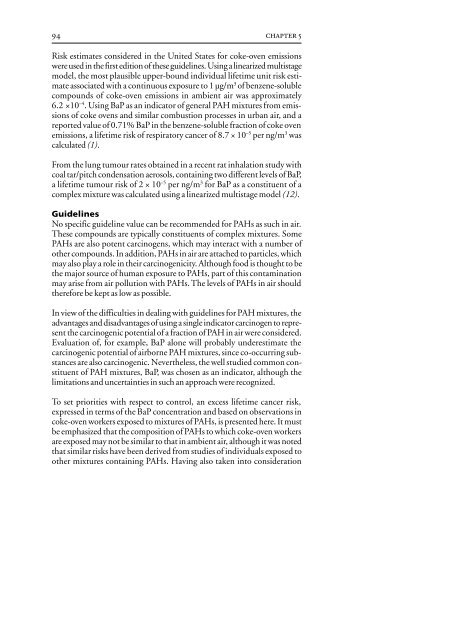Air Quality Guidelines - World Health Organization Regional Office ...
Air Quality Guidelines - World Health Organization Regional Office ...
Air Quality Guidelines - World Health Organization Regional Office ...
You also want an ePaper? Increase the reach of your titles
YUMPU automatically turns print PDFs into web optimized ePapers that Google loves.
94 chapter 5<br />
Risk estimates considered in the United States for coke-oven emissions<br />
were used in the first edition of these guidelines. Using a linearized multistage<br />
model, the most plausible upper-bound individual lifetime unit risk estimate<br />
associated with a continuous exposure to 1 µg/m 3 of benzene-soluble<br />
compounds of coke-oven emissions in ambient air was approximately<br />
6.2 ×10 –4 . Using BaP as an indicator of general PAH mixtures from emissions<br />
of coke ovens and similar combustion processes in urban air, and a<br />
reported value of 0.71% BaP in the benzene-soluble fraction of coke oven<br />
emissions, a lifetime risk of respiratory cancer of 8.7 × 10 –5 per ng/m 3 was<br />
calculated (1).<br />
From the lung tumour rates obtained in a recent rat inhalation study with<br />
coal tar/pitch condensation aerosols, containing two different levels of BaP,<br />
a lifetime tumour risk of 2 × 10 –5 per ng/m 3 for BaP as a constituent of a<br />
complex mixture was calculated using a linearized multistage model (12).<br />
<strong>Guidelines</strong><br />
No specific guideline value can be recommended for PAHs as such in air.<br />
These compounds are typically constituents of complex mixtures. Some<br />
PAHs are also potent carcinogens, which may interact with a number of<br />
other compounds. In addition, PAHs in air are attached to particles, which<br />
may also play a role in their carcinogenicity. Although food is thought to be<br />
the major source of human exposure to PAHs, part of this contamination<br />
may arise from air pollution with PAHs. The levels of PAHs in air should<br />
therefore be kept as low as possible.<br />
In view of the difficulties in dealing with guidelines for PAH mixtures, the<br />
advantages and disadvantages of using a single indicator carcinogen to represent<br />
the carcinogenic potential of a fraction of PAH in air were considered.<br />
Evaluation of, for example, BaP alone will probably underestimate the<br />
carcinogenic potential of airborne PAH mixtures, since co-occurring substances<br />
are also carcinogenic. Nevertheless, the well studied common constituent<br />
of PAH mixtures, BaP, was chosen as an indicator, although the<br />
limitations and uncertainties in such an approach were recognized.<br />
To set priorities with respect to control, an excess lifetime cancer risk,<br />
expressed in terms of the BaP concentration and based on observations in<br />
coke-oven workers exposed to mixtures of PAHs, is presented here. It must<br />
be emphasized that the composition of PAHs to which coke-oven workers<br />
are exposed may not be similar to that in ambient air, although it was noted<br />
that similar risks have been derived from studies of individuals exposed to<br />
other mixtures containing PAHs. Having also taken into consideration

















